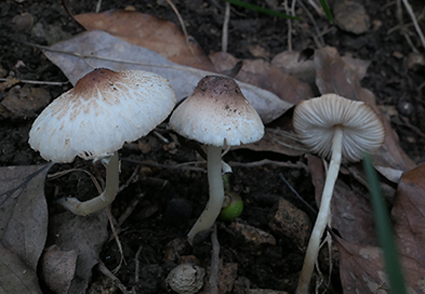Abstract
A new species, Leucoagaricus purpurascens, collected from a subtropical region in China, is described based on morphological and molecular data. Leucoagaricus purpurascens is characterized by its small basidiomata with purple discolouration when dried, the pileus with distinct umbo, the amygdaliform, ellipsoidal to oblong basidiospores, and the absence of cheilocystidia. A detailed morphological description, line drawings, colour photographs, and a phylogenetic tree showing the phylogenetic placement of the new species are provided.
References
Callac, P. & Guinberteau, C.J. (2005) Morphological and molecular characterization of two novel species of Agaricus section Xanthodermatei. Mycologia 97 (2): 416–424. https://doi.org/10.1080/15572536.2006.11832817
Doyle, J.J. & Doyle, J.L. (1987) A rapid DNA isolation procedure for small quantities of fresh leaf tissue. Phytochemical bulletin 19 (1): 11–15.
Ge, Z.W. (2010) Leucoagaricus orientiflavus, a new yellow lepiotoid species from southwestern China. Mycotaxon 111: 121–126. https://doi.org/10.5248/111.121
Ge, Z.W., Liang, J.F. & Yang, Z.L. (2019) Leucoagaricus. In: Yang, Z.L., Ge, Z.W. & Liang, J.F. (Eds.) Flora Fungorum Sinicorum vol. 52 Fungi Lepiotoidei (Agaricaceae). Beijing, Science Press, pp. 128–166.
Ge, Z.-W., Yang, Z.L., Qasim, T., Nawaz, R., Khalid, A.N. & Vellinga, E.C. (2015) Four new species in Leucoagaricus (Agaricaceae, Basidiomycota) from Asia. Mycologia 107 (5): 1033–1044. https://doi.org/10.3852/14-351
Forin, N., Tatti, A., Vizzini, A., Coppola, A. & Migliozzi, V. (2022) Leucoagaricus cupresseoides (Agaricaceae), a new species in sect. Piloselli and L. aurantiovergens and L. pseudopilatianus redescribed from Italy. Phytotaxa 536 (2): 126–140. https://doi.org/10.11646/phytotaxa.536.2.2
Hall, T.A. (1999) BioEdit: a user-friendly biological sequence alignment editor and analysis program for Windows 95/98/NT. Nucleic Acids Symposium Series 41: 95–98.
Johnson, J. (1999) Phylogenetic relationships within Lepiota sensu lato based on morphological and molecular data. Mycologia 91 (3): 443–458. https://doi.org/10.1080/00275514.1999.12061038
Justo, A., Angelini, C. & Bizzi, A. (2021) The genera Leucoagaricus and Leucocoprinus in the Dominican Republic. Mycologia 113 (2): 348–389. https://doi.org/10.1080/00275514.2020.1819142
Katoh, K. & Standley, D.M. (2013) MAFFT multiple sequence alignment software version 7: improvements in performance and usability. Molecular Biology & Evolution 30 (4): 772–780. https://doi.org/10.1093/molbev/mst010
Kornerup, A. & Wanscher, J.H. (1978) Methuen Handbook of Colour, 3rd ed. London, Methuen, 243 pp.
Liang, J.F., Xu, J. & Yang, Z.L. (2009) Divergence, dispersal and recombination in Lepiota cristata from China. Fungal Diversity 38 (10): 105–124.
Liang, J.F., Yang, Z.L., Xu, J.P. & Ge, Z.W. (2010) Two new unusual Leucoagaricus species (Agaricaceae) from tropical China with blue-green staining reactions. Mycologia 102 (5): 1141–1152. https://doi.org/10.3852/09-021
Ma, Y.R., Liu, T., Yu, X., Wei, T. & Ge, Z.-W. (2022) Six New Species of Leucoagaricus (Agaricaceae) from Northeastern China. Diversity 14 (5): 314. https://doi.org/10.3390/d14050314
Muñoz, G., Caballero, A., Marco, C. & Vizzini, A. (2012) A new Leucoagaricus species of section Piloselli (Agaricales, Agaricaceae) from Spain. IMA fungus 3 (2): 117–123. https://doi.org/10.5598/imafungus.2012.03.02.03
Nylander, J.A.A. (2004) MrModeltest v2. Program distributed by the author. Evolutionary Biology Centre, Uppsala University: 2.
Ortiz, A., Franco-Molano, A.E. & Jr, M.B. (2008) A new species of Leucoagaricus (Agaricaceae) from Colombia. Mycotaxon 106 (5): 371–378.
Rambaut, A. (2018) FigTree Version 1.4.4. Available from: http://tree.bio.ed.ac.uk/publications/ (accessed 11 June 2022)
Retnowati, A. (2015) Lepiota viriditincta (Berk. &Broome) Sacc.: a species from Bali with grey-green colour changing when dried. Floribunda 5 (3): 111–113.
Ronquist, F. & Huelsenbeck, J.P. (2003) MrBayes 3: Bayesian phylogenetic inference under mixed models. Bioinformatics 19 (12): 1572–1574. https://doi.org/10.1093/bioinformatics/btg180
Singer, R. (1948) Diagnoses fungorum novorum agaricalium. Sydowia 2: 35–36.
Singer, R. (1986) The Agaricales in modern taxonomy, 4th ed. Germamy, Koeltz Scientific Books, 981 pp.
Smith, S.A. & Dunn, C.W. (2008) Phyutility: a phyloinformatics tool for trees, alignments and molecular data. Bioinformatics 24 (5): 715–716. https://doi.org/10.1093/bioinformatics/btm619
Stamatakis, A., Hoover, P. & Rougemont, J. (2008) A rapid bootstrap algorithm for the RAxML web servers. Systematic Biology 57 (5): 758–771. https://doi.org/10.1080/10635150802429642
Vellinga, E.C. (2000) Notes on Lepiota and Leucoagaricus. Type studies on Lepiota magnispora, Lepiota barssii, and Agaricus americanus. Mycotaxon 76: 429–438.
Vellinga, E.C. (2001) Leucoagaricus. In: Noordeloos, M.E., Kuyper, Th.W. & Vellinga, E.C. (Eds.) Lisse Flora Agaricina Neerlandica. the Netherlands, A.A. Balkema Publishers, pp. 85–108.
Vellinga, E.C. (2004) Genera in the family Agaricaceae: evidence from nrITS and nrLSU sequences. Mycological Research 108 (4): 354–377. https://doi.org/10.1017/S0953756204009700
Vellinga, E.C. (2006) Lepiotaceous fungi in California, USA 3. Pink and lilac species in Leucoagaricus sect. Piloselli. Mycotaxon 98: 213–224.
Vellinga, E.C. (2007) Lepiotaceous fungi in California, USA 5. Lepiota oculata and its look-alikes. Mycotaxon 102: 267–280.
Vellinga, E.C., Kok, R. & Bruns, T.D. (2003) Phylogeny and taxonomy of Macrolepiota (Agaricaceae). Mycologia 95 (3): 442–456. https://doi.org/10.1080/15572536.2004.11833089
Vellinga, E.C., Sysouphanthong, P. & Hyde, K.D. (2011) The family Agaricaceae: phylogenies and two new white-spored genera. Mycologia 103 (3): 494–509. https://doi.org/10.3852/10-204
Vilgalys, R. & Hester, M. (1990) Rapid genetic identification and mapping of enzymatically amplified ribosomal DNA from several Cryptococcus species. Journal of Bacteriology 172 (8): 4238–4246. https://doi.org/10.1128/jb.172.8.4238-4246.1990
White, T.J., Bruns, T.D., Lee, S.H. & Taylor, J.W. (1990) Amplification and direct sequencing of fungal ribosomal RNA genes for phylogenetics In: PCR protocols, a guide to methods and applications. San Diego, Academic Press, pp. 315–322. https://doi.org/10.1016/B978-0-12-372180-8.50042-1
Yang, Z.L. (2007) Type studies on Chamaeota species described from China. Mycotaxon 100: 279–287.
Yang, Z.L. & Ge, Z.-W. (2017) Six new combinations of lepiotaceous fungi from China. Mycosystema 36: 542–551.
Yu, F., Liang, J.F., Ge, Z.-W. & Li, Y.K. (2016) Morphological and molecular evidence for a new species of Leucoagaricus from China. Sydowia 68: 41–47.
Yuan, Y., Li, Y.K. & Liang, J.F. (2014) Leucoagaricus tangerinus, a new species with drops from Southern China. Mycological Progress 13: 893–898. https://doi.org/10.1007/s11557-014-0974-2


